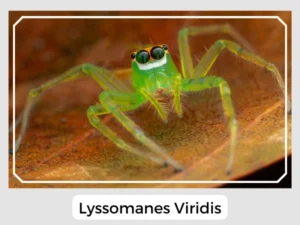Jumping spiders are super interesting! Among them, there’s a group called Lyssomanes with an impressive 90 different kinds. You can find them in Central and South America and even in the southern parts of the USA. In this post, we’re going to share cool facts about these lively Lyssomanes spiders.
Protectively laid under leaves, the eggs of Lyssomanes are pale green. A single clutch typically contains a range of 30 to 70 eggs.
Born green, these spiderlings are quick to disperse shortly after their birth.
Unlike many of their arachnid relatives, most Lyssomanes species don’t engage in web-building, either for hunting or sheltering purposes.
Yes, Lyssomanes Spiders have venom. They use it to help them catch the tiny bugs they eat. For us, it’s not really strong or worrying.
Lyssomanes Spiders can bite, but they’re usually calm and keep to themselves. They’d only bite if they felt super scared.
Jumping spiders, like Lyssomanes, maintain ecological balance by controlling insect populations. Their webless hunting needs sharp vision and agility, emphasized by their large anterior eyes.
Natural Predator: Various birds and larger arachnids often prey on Lyssomanes. Their vibrant coloration, while beneficial for camouflage amidst foliage, can sometimes make them a target for sharp-eyed predators.
Prey-Predator Dynamics: Mostly, Lyssomanes feed on mites, ants, and other spiders. This diet choice plays a significant role in maintaining the insect balance within their habitat. By preying on these insects, they ensure that no single species becomes too dominant, maintaining diversity and balance.
Relationship with Humans: Generally, Lyssomanes spiders are harmless to humans. While they might bite when threatened or provoked, their venom poses no significant health risk. Their primary interaction with humans comes in the form of intrigue, as many researchers and enthusiasts are drawn to their unique physical features and behaviors.
| Lifespan | Typically, Lyssomanes live for about a year. |
| Distribution | Their presence is mainly felt across South and Central America. |
| Habitat | These spiders are most commonly found amidst the foliage in moist areas. |
| Diet | Their palate includes mites, ants, and other spiders. |

In conclusion, the Lyssomanes genus stands as a testament to the fascinating world of jumping spiders, offering a blend of ecological importance, unique behavior, and captivating physical attributes. These spiders, though small, play a significant role in the tapestry of their ecosystem.
Jumping spiders are super interesting! Among them, there’s a group called Lyssomanes with an impressive 90 different kinds. You can find them in Central and South America and even in the southern parts of the USA. In this post, we’re going to share cool facts about these lively Lyssomanes spiders.
Protectively laid under leaves, the eggs of Lyssomanes are pale green. A single clutch typically contains a range of 30 to 70 eggs.
Born green, these spiderlings are quick to disperse shortly after their birth.
Unlike many of their arachnid relatives, most Lyssomanes species don’t engage in web-building, either for hunting or sheltering purposes.
Yes, Lyssomanes Spiders have venom. They use it to help them catch the tiny bugs they eat. For us, it’s not really strong or worrying.
Lyssomanes Spiders can bite, but they’re usually calm and keep to themselves. They’d only bite if they felt super scared.
Jumping spiders, like Lyssomanes, maintain ecological balance by controlling insect populations. Their webless hunting needs sharp vision and agility, emphasized by their large anterior eyes.
Natural Predator: Various birds and larger arachnids often prey on Lyssomanes. Their vibrant coloration, while beneficial for camouflage amidst foliage, can sometimes make them a target for sharp-eyed predators.
Prey-Predator Dynamics: Mostly, Lyssomanes feed on mites, ants, and other spiders. This diet choice plays a significant role in maintaining the insect balance within their habitat. By preying on these insects, they ensure that no single species becomes too dominant, maintaining diversity and balance.
Relationship with Humans: Generally, Lyssomanes spiders are harmless to humans. While they might bite when threatened or provoked, their venom poses no significant health risk. Their primary interaction with humans comes in the form of intrigue, as many researchers and enthusiasts are drawn to their unique physical features and behaviors.
| Lifespan | Typically, Lyssomanes live for about a year. |
| Distribution | Their presence is mainly felt across South and Central America. |
| Habitat | These spiders are most commonly found amidst the foliage in moist areas. |
| Diet | Their palate includes mites, ants, and other spiders. |

In conclusion, the Lyssomanes genus stands as a testament to the fascinating world of jumping spiders, offering a blend of ecological importance, unique behavior, and captivating physical attributes. These spiders, though small, play a significant role in the tapestry of their ecosystem.